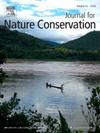城市公园在青蛙多样性保护中的作用有限
IF 2.5
3区 环境科学与生态学
Q2 BIODIVERSITY CONSERVATION
引用次数: 0
摘要
全球人口已达76亿,其中55.3%生活在城市地区。世界主要城市建立城市公园最初是为了审美和娱乐价值,但最近的研究强调了其对生物多样性保护的价值。然而,在新热带地区,很少有研究评估它们在这方面的有效性。在这里,我们解决了以下问题:城市公园在保护青蛙多样性方面发挥了什么作用?研究了城市公园及周边保护区蛙类繁殖生境的物种丰富度和繁殖方式的空间分布特征。我们的研究结果表明,城市公园支持有限数量的青蛙种类和繁殖模式,这些模式往往是通用性的,并且很少受到保护。考虑到城市公园的设计往往不是为了尽量减少人类活动对生物多样性的影响,我们认为城市规划必须超越娱乐和审美目标,有意识地纳入生物多样性保护,确保城市既支持人类福祉,也支持野生动物。本文章由计算机程序翻译,如有差异,请以英文原文为准。
Limited role of urban parks in frog diversity conservation
Global human population had reached 7.6 billion people, of which 55.3% lives in urban areas. Major cities worldwide have established urban parks initially for aesthetic and recreational values but recent research have highlighted its value for biodiversity conservation. However, little research in the Neotropical region has been done to evaluate their effectiveness for this purpose. Here, we addressed the following question: What role do urban parks play in the conservation of frog diversity? We examined the spatial distribution of species richness and reproductive modes of frogs in breeding habitats within urban parks and nearby protected areas. Our findings indicate that urban parks support a limited number of frog species and reproductive modes, which are often generalists and of little concern for conservation. Considering that urban parks are often not designed to minimize the impacts of human activities on biodiversity, we argue that urban planning must move beyond recreational and aesthetic goals to intentionally incorporate biodiversity conservation, ensuring cities support both human well-being and wildlife.
求助全文
通过发布文献求助,成功后即可免费获取论文全文。
去求助
来源期刊

Journal for Nature Conservation
环境科学-生态学
CiteScore
3.70
自引率
5.00%
发文量
151
审稿时长
7.9 weeks
期刊介绍:
The Journal for Nature Conservation addresses concepts, methods and techniques for nature conservation. This international and interdisciplinary journal encourages collaboration between scientists and practitioners, including the integration of biodiversity issues with social and economic concepts. Therefore, conceptual, technical and methodological papers, as well as reviews, research papers, and short communications are welcomed from a wide range of disciplines, including theoretical ecology, landscape ecology, restoration ecology, ecological modelling, and others, provided that there is a clear connection and immediate relevance to nature conservation.
Manuscripts without any immediate conservation context, such as inventories, distribution modelling, genetic studies, animal behaviour, plant physiology, will not be considered for this journal; though such data may be useful for conservationists and managers in the future, this is outside of the current scope of the journal.
 求助内容:
求助内容: 应助结果提醒方式:
应助结果提醒方式:


